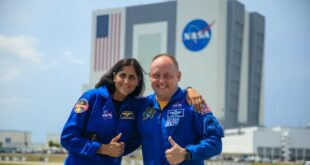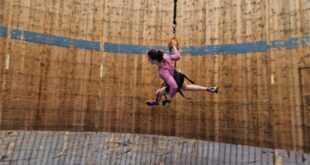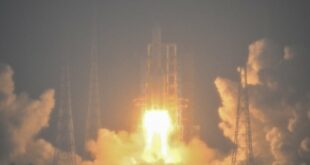Company confirms craft landed upright on moon 6 days after taking off from Florida's Kennedy Space Center

A private lander touched down on the moon Thursday but managed just a weak signal back, as flight controllers scrambled to gain better contact with the first U.S. spacecraft to reach the lunar surface in more than 50 years.
Tension mounted in the company's command centre in Houston, as controllers awaited a signal from the spacecraft some 400,000 kilometres away, which arrived about 10 minutes later.
Despite the spotty communication, Intuitive Machines, the company that built and managed the craft, which is called Odysseus, confirmed it had landed upright.
But it did not provide additional details, including whether the lander had reached its intended destination near the moon's south pole.
The company ended its live webcast soon after identifying a lone, weak signal from the lander.
"We can confirm, without a doubt, our equipment is on the surface of the moon," mission director Tim Crain reported, as tension built in the company's Houston control centre.
"I know this was a nail-biter, but we are on the surface and we are transmitting. Welcome to the moon," added Intuitive Machines CEO Steve Altemus.
Data was finally starting to stream in, according to a company announcement two hours after touchdown.
The final few hours before touchdown were loaded with extra stress when the lander's laser navigation system failed.
The company's flight control team had to press an experimental NASA laser system into action, with the lander taking an extra lap around the moon to allow time for the last-minute switch.
With this change finally in place, Odysseus descended from a moon-skimming orbit and guided itself toward the surface, aiming for a relatively flat spot among all the cliffs and craters near the south pole.
Your order was delivered… to the Moon! 📦<a href="https://twitter.com/Int_Machines?ref_src=twsrc%5Etfw">@Int_Machines</a>' uncrewed lunar lander landed at 6:23pm ET (2323 UTC), bringing NASA science to the Moon's surface. These instruments will prepare us for future human exploration of the Moon under <a href="https://twitter.com/hashtag/Artemis?src=hash&ref_src=twsrc%5Etfw">#Artemis</a>. <a href="https://t.co/sS0poiWxrU">pic.twitter.com/sS0poiWxrU</a>
—@NASA
The lander's choreographed descent was the first for the U.S. since 1972, when Apollo 17's Gene Cernan and Harrison Schmitt left the last bootprints in the desolate grey dust.
Odysseus reached the moon's orbit Wednesday, six days after rocketing from Kennedy Space Centre in Florida.
The six-footed carbon fibre and titanium lander — towering 4.3 meters — carried six experiments for NASA.
The space agency gave the company $118 million US to build and fly the lander, part of its effort to commercialize lunar deliveries ahead of the planned return of astronauts in a few years.
Intuitive Machines' entry is the latest in a series of landing attempts by countries and private outfits looking to explore the moon and, if possible, capitalize on it.
Japan scored a lunar landing last month, joining earlier triumphs by Russia, U.S., China and India.
A Pittsburgh company, Astrobotic Technology, gave it a shot last month, but was derailed by a fuel leak that resulted in the lander plunging back through Earth's atmosphere and burning up.
Intuitive Machines' target was 300 kilometres shy of the south pole, around 80 degrees latitude and closer to the pole than any other spacecraft has come.
The site is relatively flat, but surrounded by boulders, hills, cliffs and craters that could hold frozen water, a big part of the allure.
The lander was programmed to pick, in real time, the safest spot near the so-called Malapert A crater.
The solar-powered lander was intended to operate for a week, until the long lunar night.
Besides NASA's tech and navigation experiments, Intuitive Machines sold space on the lander to Columbia Sportswear to fly its newest insulating jacket fabric; sculptor Jeff Koons for 125 mini moon figurines; and Embry-Riddle Aeronautical University for a set of cameras to capture pictures of the descending lander.
*****
Credit belongs to : www.cbc.ca
 MaharlikaNews | Canada Leading Online Filipino Newspaper Portal The No. 1 most engaged information website for Filipino – Canadian in Canada. MaharlikaNews.com received almost a quarter a million visitors in 2020.
MaharlikaNews | Canada Leading Online Filipino Newspaper Portal The No. 1 most engaged information website for Filipino – Canadian in Canada. MaharlikaNews.com received almost a quarter a million visitors in 2020.







